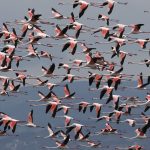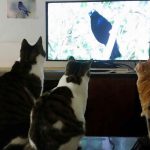I’ve made it to Texas. Yee-haw! The first thing I noticed as I touched down at DFW was how pretty the grounds are, at least for an international airport. Striking emerald swathes of short grass separating runways are actually broad enough to harbor birds, which explains why, in addition to expected species like Great-tailed Grackle and Mourning Dove, I spotted a number of meadowlarks. Based on the extensive white in their tails, I reckon (that’s Texan for “think”) they were Eastern Meadowlarks. The southwestern population of Sturnella magna is known as Lilian’s Meadowlark. Now that I’ve logged the Lilian’s, I’m ready for the AOU to grant these guys full species status. Guess I’ll have to contact my congressperson or something.
Though I landed in late afternoon, there was still enough daylight to warrant a quick birding excursion. Research revealed a promising locale just northwest of the airport. Grapevine Lake, or as the locals call it, Lake Grapevine, is an artificial nody of water said to attract an abundance of shorebirds and waterfowl. Fort Worth Audubon recommended following White Chapel Blvd to its terminus, which brought me to a sensational riparian habitat rich with live oaks and scrub bursting with birdsong. In fact, the very first bird to greet me was a Greater Roadrunner strutting around like a turkey. That’s a sure sign you’re not in New York anymore!
It was clear that, without a scope, I was ill-equipped to suss out all the species on the lake, though I did note distant Double-crested Cormorant, Great Blue Heron, Great Egret, and Forster’s Terns, my first terns of spring. But I’ve had enough ducks in the last few months anyway. The woods yielded species I see plenty of at home such as Northern Mockingbird, Northern Cardinal, American Crow, Red-tailed Hawk, and Blue Jay, but also fun birds like Spotted Towhee, Ruby-crowned Kinglet, Yellow-rumped Warbler, Cedar Waxwing, Eastern Bluebird, and the most exquisite Blue-gray Gnatcatcher I’ve ever seen. The sparrows were superlative. Besides the towhees, Dark-eyed Juncos, White-throated Sparrows, and even Lincoln’s Sparrows made the scene. The dominant sparrow, though, was definitely White-crowned. Because I see this species in large flocks so sparingly, I always try to turn the first winter birds, with their bright rufous crowns, into other types of sparrows. Not this time. I’ll get those other sparrows later in the week!
The warmth of the day, coupled with the surpassing pleasantness of Lake Grapevine’s fragrant, wooded bank, could only be described as intoxicating. Regrettably, the failing light made further investigation fruitless. However, two incidents that occurred as I was leaving really made my day. The first was a buzzy chickadee call. Initially, I thought nothing of it. Further listening caused me to wonder if Texas tits sang with an accent. Then I realized that Black-capped Chickadees don’t frequent the Lone Star State. What I was hearing, and subsequently seeing, was my life Carolina Chickadee. I can’t believe it’s taken me so long to spot this charming, but common bird.
When I first arrived at the lake, I noticed a distant flock of vultures circling the opposite bank. The massive grouping clearly contained many Turkey Vultures, but I suspected some Black as well based on profile. They were too far way, unfortunately, for me to detect the telltale white wingtips. As I headed back to the highway, almost but not quite sated from my taste of Texan avifauna, I came upon an intimidating gang of Black Vultures loitering on a radio tower. I’ve only seen the likes of such a mob, offering incredible views both in flight and repose, down in Belize. Such an encounter may not sound exotic, but it made me feel like I’ve arrived in a very special place.













Welcome to Texas! I’m glad you’ve already been treated to some of our great birds. Hopefully this evening’s sightings are only the beginning.
The meadowlark situation is complex. At this time of year, both Eastern and Western birds occur in north-central Texas. The birds cannot be reliably separated by plumage in the field except under extraordinary viewing conditions. Songs and calls are generally necessary to make a positive ID.
Also, several subspecies of Sturnella magna occur in Texas. Lilian’s occurs in the Trans-Pecos (400+ miles southwest) but is not known to occur here.
Perhaps we’ll have a chance to study meadowlarks later in the week.
Subspecies are tough…and congrats on the Carolina Chickadee!
Can’t believe you had to go all the way to Texas to get a Carolina when you could have hopped a train to Philly or DC anytime…. );–) Seriously I’m delighted you’re having good birding in my native state. If you get the chance, visit Cedar Ridge Preserve just south of downtown Dallas — it’s a little taste of the Hill Country!
http://www.audubondallas.org/cedarridge.html
That’s a shame about those meadowlarks. Sibley didn’t say anything about the Trans-Pecos!
Enchilada, no one is as surprised as I am that it tok a trip to Texas to find a Carolina Chickadee. I’ve been up and down the east coast for years. I even spent a week in North Carolina. These birds are crafty. Also, thanks for the tip. David and I have a great Texas trip planned for Thursday. WIth luck, it’ll be extremely successful.
That is one thing I definitely don’t like (at all) about the Sibley guides:
He teases you with the subspecies and lures you into subspecific identification, so you go for it and try, but halfway through he seems to just leave you alone and you’re completely lost.
I was at Cedar Ridge in January during the cold & icy spell, so didn’t see much bird life, but it’s a beautiful place and very unlike most of the countryside in the immediate vicinity of Dallas-Ft. Worth. BTW, delighted you saw the roadrunner — I saw one once in that general area near the lake; it actually flew a bit (across the road). Keep up the Texas reports — I’m gettin’ seriously homesick!
Hey Mike,
Enjoy your time in Texas! I can’t wait to hear about your adventures.
Hey Mike,
Enjoy your time in Texas! I can’t wait to hear about your adventures.